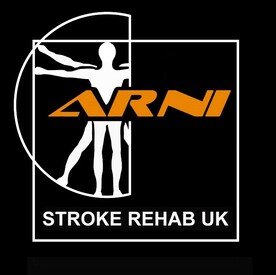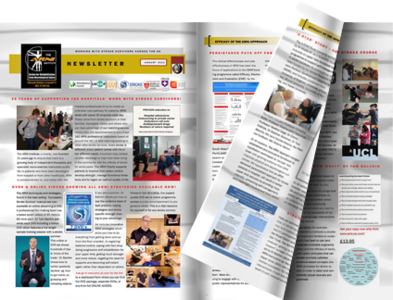Try to do MORE with your more-affected upper limb by yourself each day (ie work towards a new goal, and check retention during your ADLs constantly afterwards (because you can lose ability, just like strength ; which is shockingly easy to lose). Repeated attempts to use your affected limbs in training creates a form of practice that can potentially lead to further improvement in performance. The ideal is to find oneself in a ‘virtuous circle’, in which spontaneous limb use and motor performance will reinforce each other and re-teach your body to control the position of an affected limb.
To find out if there's an ARNI trainer near you who can help you call 0203 053 0111 or email support@arni.uk.com
If you like this post then please share it with others. Each time that you share a post, you can directly help other people – as who knows which people in the world might find us and gain, either directly from the charity or simply by being able to copy an ‘innovative and useful’ move/trick of the trade that might help them manage after stroke.
Every time you share, you could directly help someone – as knowledge is power 😉
www.arni.uk.com
#neurorehabilitation #strokeexercise #strokesurvivorscan #neurorehab #exerciseafterstroke #strokerecovery #neuroplasticity #strokerehab #strokerecoveryexercises #strokerehabilitation
... See MoreSee Less
Please be generous today to your favourite Stroke Rehab Charity! We REALLY need your help. We rely purely on kind donations... thank you! Happy Christmas from Dr Tom Balchin and staff at ARNI! PLEASE DONATE VIA PAYPAL BUTTON AT arni.uk.com/support-us/
... See MoreSee Less
🔬 The SuperNOVA Stent Shows Stellar Results! 🚀💡 Exciting news is emerging from the latest clinical research that could offer a bright future for stroke patients needing mechanical thrombectomy! The innovative SuperNOVA Stent (Neurovascular Ostial Advanced Stent Retriever) has just been demonstrated to be both safe and effective for treating acute ischemic strokes. This is a big deal in the world of endovascular therapy.
For those unfamiliar, mechanical thrombectomy involves physically removing a blood clot from a blocked artery in the brain, a procedure that has revolutionised severe stroke care. The SuperNOVA stent is a next-generation device designed to potentially offer improved performance in retrieving those tricky, large vessel occlusions. The recent studies have confirmed its efficacy, showing high rates of successful recanalisation (restoring blood flow) with excellent safety profiles for patients.
ARNI Stroke Rehab UK says that this breakthrough means clinicians in the UK may soon have another highly effective tool in their arsenal to combat strokes rapidly. Faster, more complete clot removal directly translates to better outcomes, reduced disability and improved quality of life for survivors 🙏🧠💙
www.arni.uk.com
#ARNIstrokerehab #stroketreatment #supernovastent #neuroscience #MedicalBreakthrough #neurovascular #strokesurvivor #HopeForFuture #ScienceNews #HealthcareInnovation
... See MoreSee Less
🌟 Inspiring News from Galway! Meet Geraldine Gaffney, Our New Patient Champion! 🌟Geraldine Gaffney, from Salthill, is a remarkable stroke survivor herself, like man of ARNI Stroke Rehab UK page. After her stroke in 2024, she has has recently contributed back by graduating as a certified Patient Champion for a national heart and stroke charity!
This is such a wonderful achievement and a testament to her strength and commitment to helping others navigate their own recovery journeys. Geraldine’s experience with her own stroke has given her unique insights and empathy, which she will now channel into supporting other patients and their families.
As a Patient Champion, she will be using her lived experience to provide invaluable peer support, raise awareness about heart disease and stroke prevention, and advocate for better patient care within the community. Her journey from patient to champion is exactly what a successful recovery often is seen to feature; turning a personal challenge into a powerful force for good.
We know you know what this is about: it's about validation that there is life, purpose and immense strength after a stroke. Huge congratulations to Geraldine on this well-deserved recognition! We are very proud of her and the vital work she will be doing to support others. What an inspiration! 💖🧠☘️
www.arni.uk.com
#ARNIstrokerehab #StrokeSurvivor #PatientChampion #Galway #Inspiration #HeartAndStrokeCharity #PeerSupport #StrongerTogether
... See MoreSee Less
My aim is to show you how to achieve a successful ‘life after stroke’ whatever your ultimate goal is: whether for you this is about enhancing your quality of life and coping abilities or seeking ultimately to get back to work. Your ambition must be to participate fully once again with all that life holds. I hope that this volume helps you to accomplish this and be the best you can be.
Get your copy now!
www.strokesolutions.co.uk/product/had-a-stroke-now-what-book/https://www.strokesolutions.co.uk/pr...
#ARNIstrokerehab #arnistrokecharity #stroke #strokesurvivors #neuroplasticity #neurorehab
... See MoreSee Less
Imagine a future where stroke survivors can relearn brand-new signals and regain function using advanced technology that talks directly to their brain. Scientists have just achieved an incredible breakthrough: they’ve created a revolutionary, soft, wireless implant that uses tiny, gentle flashes of light to send information straight into the brain!
This isn't science fiction anymore; it’s about leveraging neuroplasticity... This soft implant acts like an artificial pathway, potentially bypassing damaged areas to help the brain learn entirely new functional signals. For stroke survivors struggling with movement, sensation, or communication issues, this technology offers a tantalising possibility of retraining the brain in ways we previously could only dream of.
The fact that the implant is soft and wireless is also helpful; it reduces discomfort and makes it much more practical for long-term use. While this is still a cutting-edge research finding and not yet available for clinical use, ARNI Stroke Rehab UK thinks that it provides a bit of an indicator about the future of stroke recovery methods 🙏🌟
www.arni.uk.com
#ARNItrokecharity #StrokeSurvivor #Neuroscience #Neuroplasticity #BrainImplant #MedicalBreakthrough #HopeForFuture #ScienceNews #Innovation
... See MoreSee Less
NORTH LONDON SUCCESS STORY
I had a severe stroke in February 2012 caused by a bleed on the brain. I spent about 2 weeks in a coma and as a result I lost the use my left leg and arm. I was in Hospital for 5 months before discharge.
In many respects I have been very lucky in that having spent 37 years in a Cavalry Regiment of the British Army and also volunteered and spent 3 years serving as a paratrooper with the airborne forces. So I have been reasonably fit and active all my life. This has all helped to give me a fairly robust view to adversity and a stronger mental approach towards what life can throw one’s way. To this must be added the invaluable help and encouragement given to me by my wife Elizabeth and family who have thought laterally to get round problems where and when they have cropped up.
In July 2014 a friend who had also had a stroke introduced me to Gabriella Pásztor and ARNI, for which I shall be forever grateful!! On my first meeting Gabi instantly gave me encouragement that my progress had not plateaued and has astonished me by the simplest changes that have made such a difference. With her depth of knowledge and skill and encouragement, my confidence and abilities have grown. She has been able to push me further over the last year, and that, and the many progressive exercises she has shown me, are helping me enormously.
I am much stronger and more confident in my ability do things which others do as a matter of course. Such as going up and down awkward steps that have no handrails and going into strange environments, and even being able to get up from the floor! Most people also remark as to how well I look and seem.
In summary, my year spent with Gaby has left me far better prepared to face life’s challenges. The exercises I have been given have been progressively made more challenging so that I feel that I can continue to achieve more generally.
www.arni.uk.com
#ARNIstrokerehab #arnistrokecharity #strokesurvivors #neuroplasticity #neurorehab #strokeexercise #strokerecovery #strokerehabilitation #strokesurvivorscan #strokerehab #arnistrokerehab #neurorehabilitation
... See MoreSee Less
For many stroke survivors, the fear of falling and reliance on traditional walkers that cause hunching posture are major challenges. But a lot of survivors are discovering the LifeGlider mobility aid and absolutely loving the difference it makes - this innovative device is changing lives by helping users walk upright, often hands-free, and most importantly, with virtually no risk of falling.
Users often share to us at ARNI that while it takes practice to get used to, the LifeGlider is far superior to a conventional walker because it provides stability by supporting the centre of gravity and securing the pelvis with a belt and saddle system.
This unique design allows individuals to stand tall and engage their muscles differently than traditional aids. Many survivors report a huge boost in confidence, a reduction in the fear of falling, and even the ability to do everyday tasks like making breakfast or walking without a therapist constantly by their side. The aim is to help people reclaim their independence and dignity.
While scientific studies on the LifeGlider specifically are often experiential or focus on feasibility, a broader body of research into neurological rehabilitation consistently highlights the effectiveness of intensive, task-related mobility training and the use of assistive devices to improve gait and balance.
The core principle of the LifeGlider - enabling consistent, safe walking practice - aligns with evidence-based strategies for promoting neuroplasticity and recovery. So, if you struggle with balance and fear falls, it might be the tool you need to get moving more safely and independently!
Check out customer stories on their website or talk to your ARNI Stroke Rehab Instructor to see if it’s the right fit for your unique recovery journey.
www.arni.uk.com
#ARNIStrokeRehab #StrokeRecovery #LifeGlider #MobilityAid #FallPrevention #NeuroRehab #StrokeSurvivor #Independence #PhysicalTherapy #ConfidenceBoost
... See MoreSee Less


